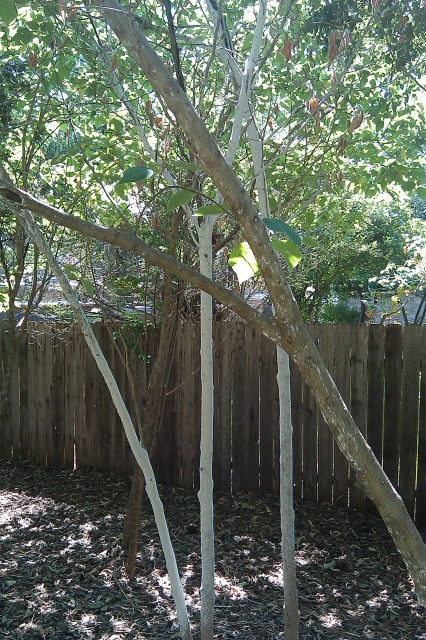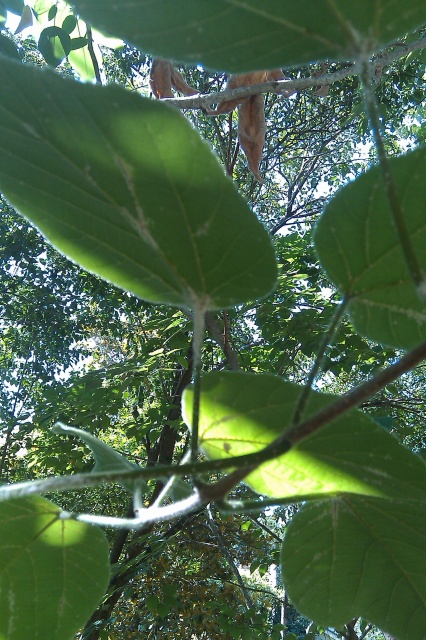Question Trees in Yard
Trees in Yard
QUESTION: Jim -
I've seen similar postings previously, but we've got this white powdery
substance coating the mulberry trees in our yard in Austin, TX. I don't know
whether this is powdery mildew or not (see pictures). There is some of it on
the underside of healthy leaves, but many leaves are turning brown.
I honestly don't mind the loss of the mulberry trees (their runners are a
nuisance), but am concerned about our mountain juniper and other trees. We
put weed cloth down this spring and covered with mulch ... that might be
limiting the amount of water the mulberry trees are getting.
What do you think we're dealing with? And what do we need to so?
ANSWER: This is an insect called bark lice.
Bark lice are small, brown insects that live on the rough bark of hardwood trees, especially live oak trees. Contrary to their name, bark lice are not parasitic on humans or animals, rather they live on the bark of trees, feeding on fungi, lichens and dead insects. They serve as "clean-up" crew of sorts for the tree. They do not eat leaves or bore into the tree, or consume the bark of the tree. Because they are small and vulnerable, bark lice have developed a protective means for their survival: silken webs. Seemingly overnight, a colony of bark lice can envelop the trunk of a large tree with a silken covering. This silk covering affords bark lice the protection from predators while they feed underneath.
Treating bark lice is not necessary because they cause no harm. Some homeowners think they are unsightly and wish them to be gone. If treatment is absolutely desired, there are some options available. One option is soapy water. A concentration of 2 tablespoons of liquid dish soap per gallon of water will affect bark lice. Removing the webs with a stream of water by itself will not kill the bark lice, but it will stimulate them to rebuild the webs within a few hours. Insecticide sprays to the trunk will control these insects as well.
Here is a link to more information on bark lice. http://www.ag.auburn.edu/enpl/bulletins/barklice/barklice.htm
---------- FOLLOW-UP ----------
 Bark lice on leaf?
Bark lice on leaf?
QUESTION: Jim -
Thanks for your response, but I not having seen any actual lice, I'm still
questioning the diagnosis. In the writeup, I noted that the white stuff is
accumulating on leaves, which I don't see in the descriptions from the various
references on bark lice.
I am attaching a photo of the underside of the leaves, just to provide more
information (I have yet another photo, but I can only post one at a time).
If you could again confirm, that would be great.
Thanks again,
Jonathan
AnswerUsually powdery mildew is on the leaves and the small stems near the leaves and not on the tree trunk. I read into your question that this was on the trunks. Sorry that is why I went with the bark lice. Bark lice do not usually spread to the leaves. If the powdery mildew has spread onto the trunk and limbs this is the worst case of powdery mildew I have heard of but it is possible. And is about the only other pest that leaves the white type covering.
Powdery mildews, as the name implies, often appear as a superficial white or gray powdery growth of fungus over the surface of leaves, stems, flowers, or fruit of affected plants. These patches may enlarge until they cover the entire leaf on one or both sides. Young foliage and shoots may be particularly susceptible. Leaf curling and twisting may be noted before the fungus is noticed. Severe powdery mildew infection will result in yellowed leaves, dried and brown leaves, and disfigured shoots and flowers. Although it usually is not a fatal disease, powdery mildew may hasten plant defoliation and fall dormancy, and the infected plant may become extremely unsightly.
In many cases, powdery mildew diseases do little damage to overall plant health, and yearly infections can be ignored if unsightliness is not a major concern. For example, lilacs can have powdery mildew each year, with little or no apparent effect on plant health. On some plants, powdery mildews can result in significant damage. Thus, fungicides must be used to achieve acceptable control. For best results with fungicides, spray programs must begin as soon as mildews are detected. Spray on a regular schedule, more often during cool, damp weather. Use a good spreader-sticker with the fungicides. Be sure and cover both surfaces of all leaves with the spray. Fungicides generally recommended for powdery mildew control include: Triadimefon (Bayleton, Strike); Triforine (Funginex), Thiophanate-methyl (Cleary's 3336, Domain# and Propiconazole #Banner).
I would spray the lower plants but the tree will be hard to spray and the leaves will be dropping soon anyway so I would not try and spray it. On many trees, the disease causes little or no damage, therefore, control is not necessary.







